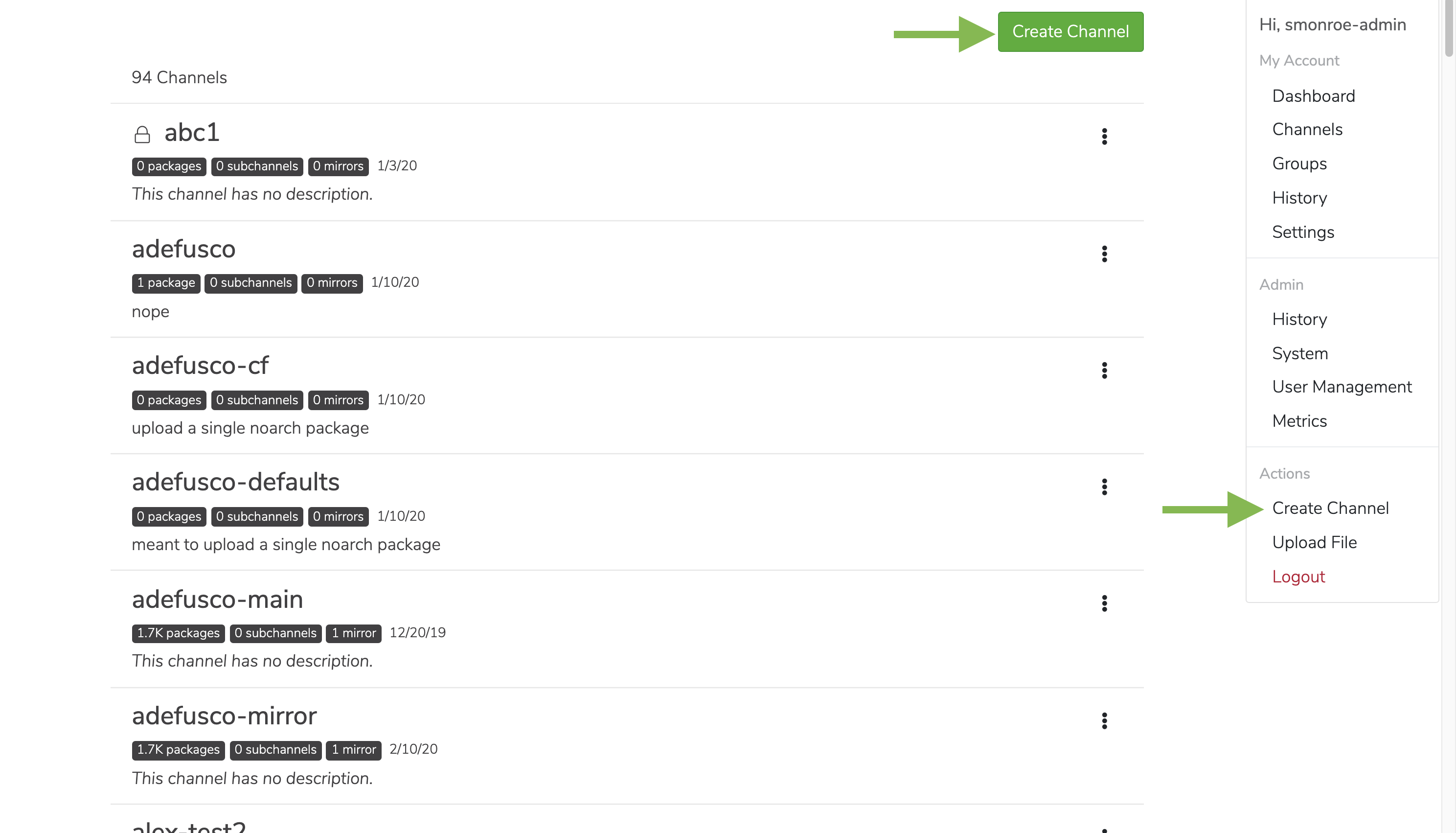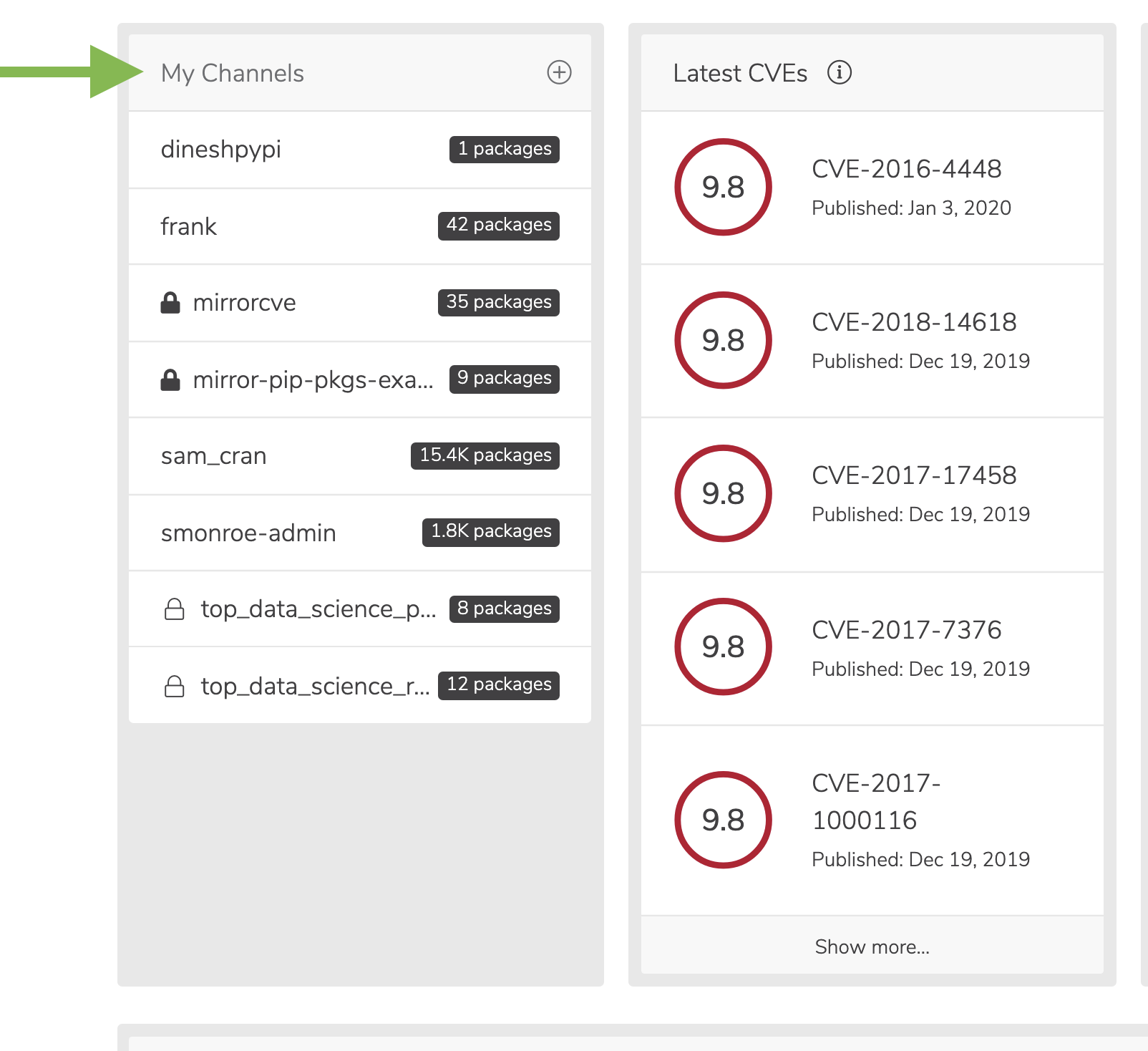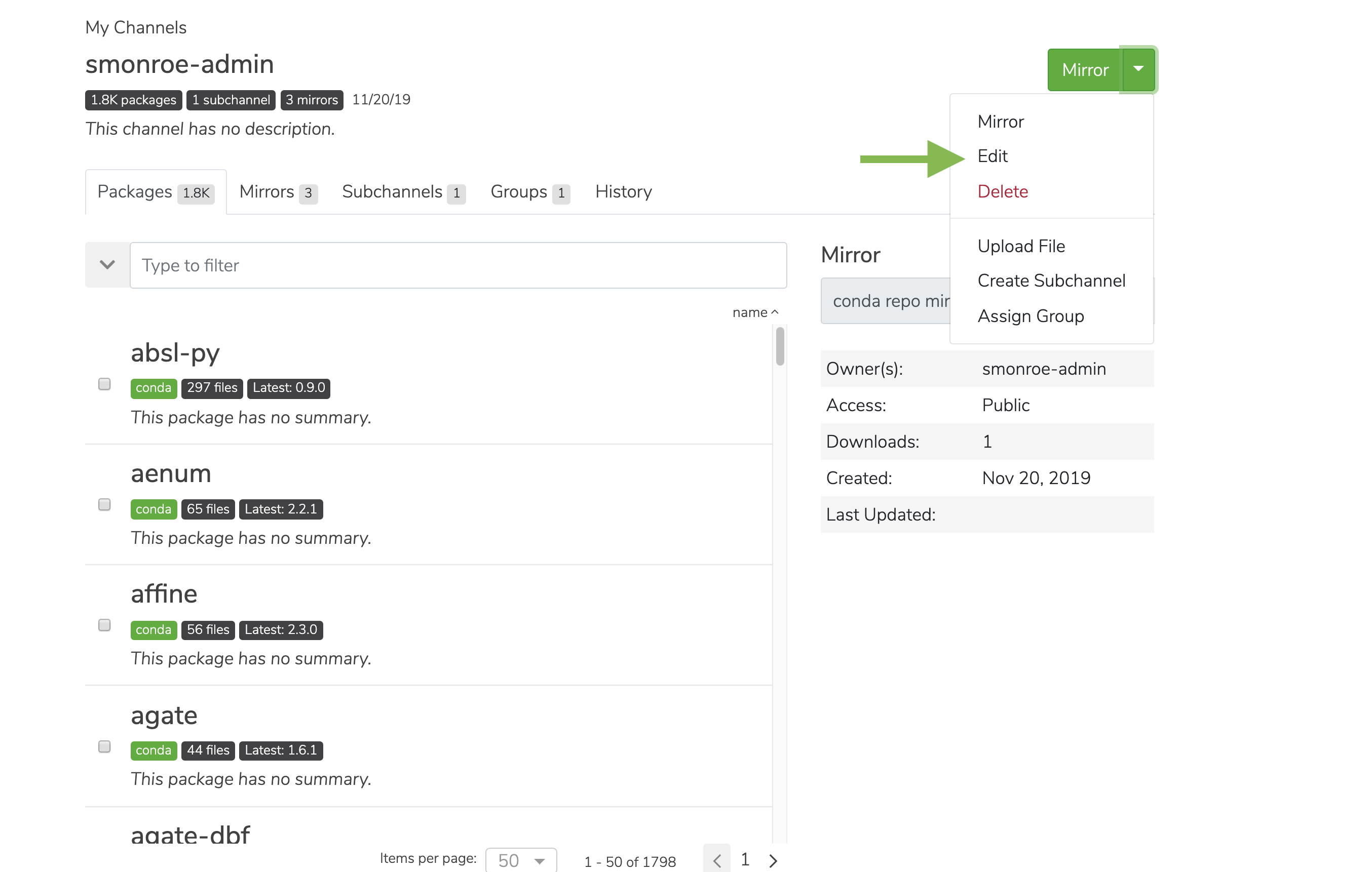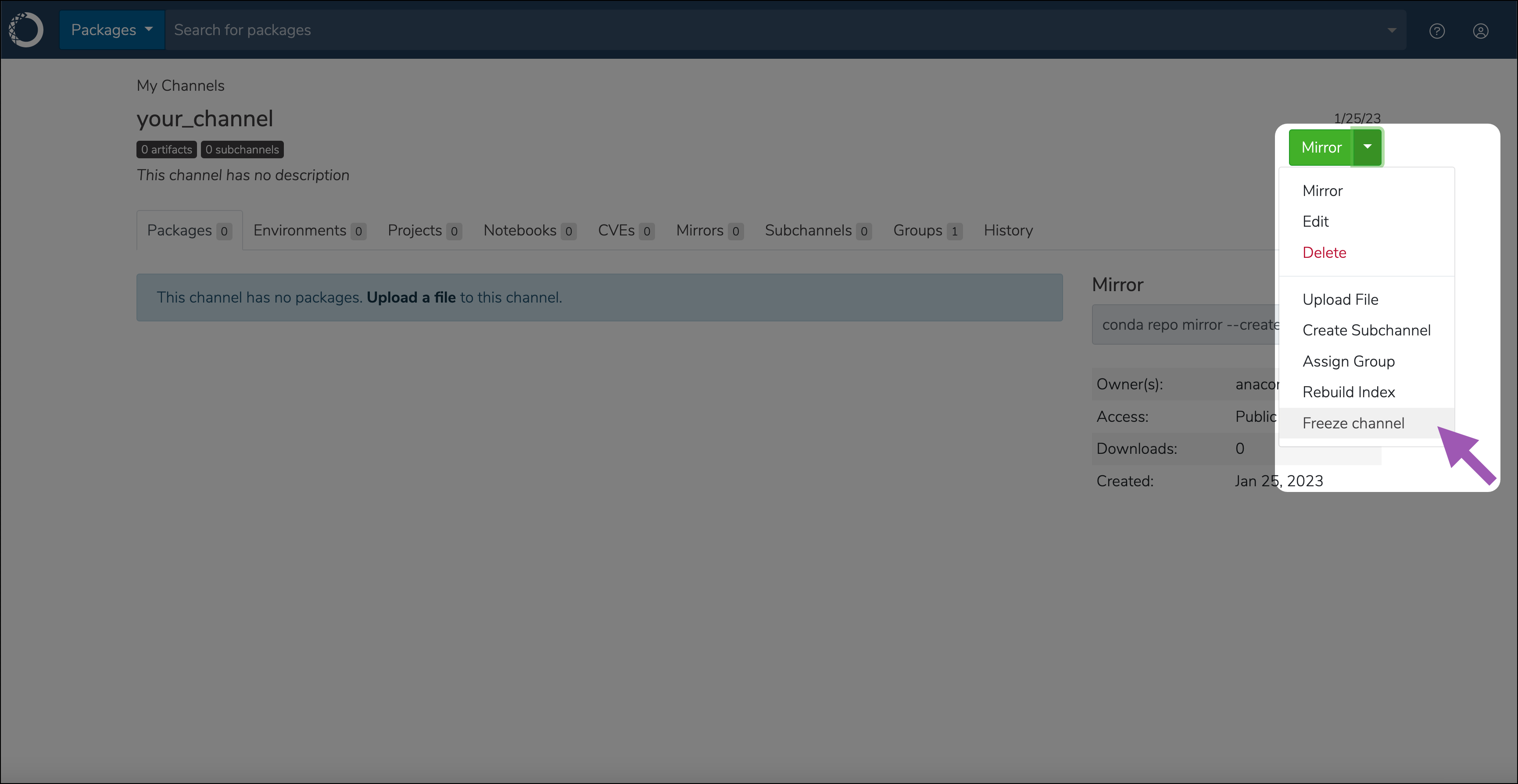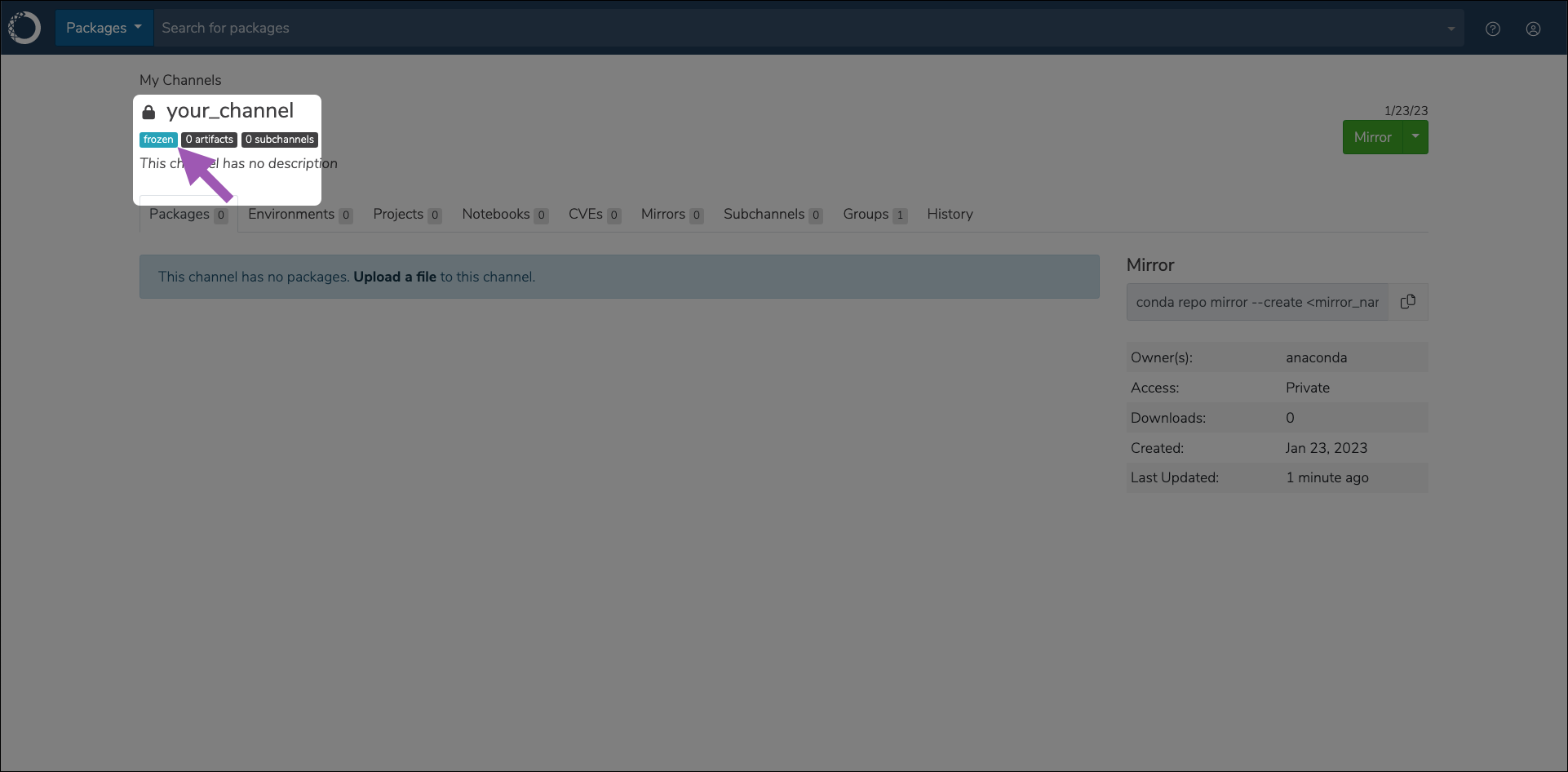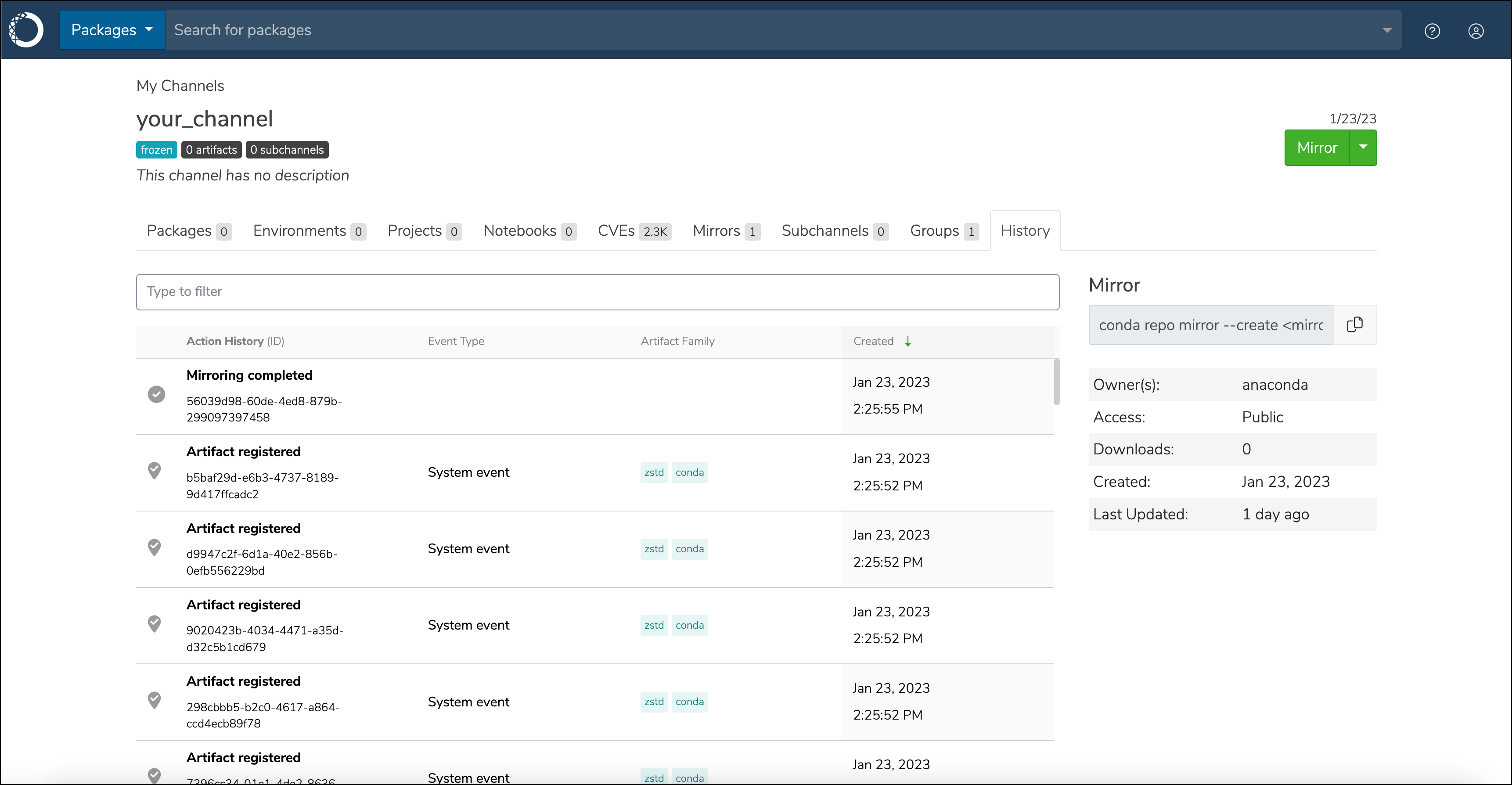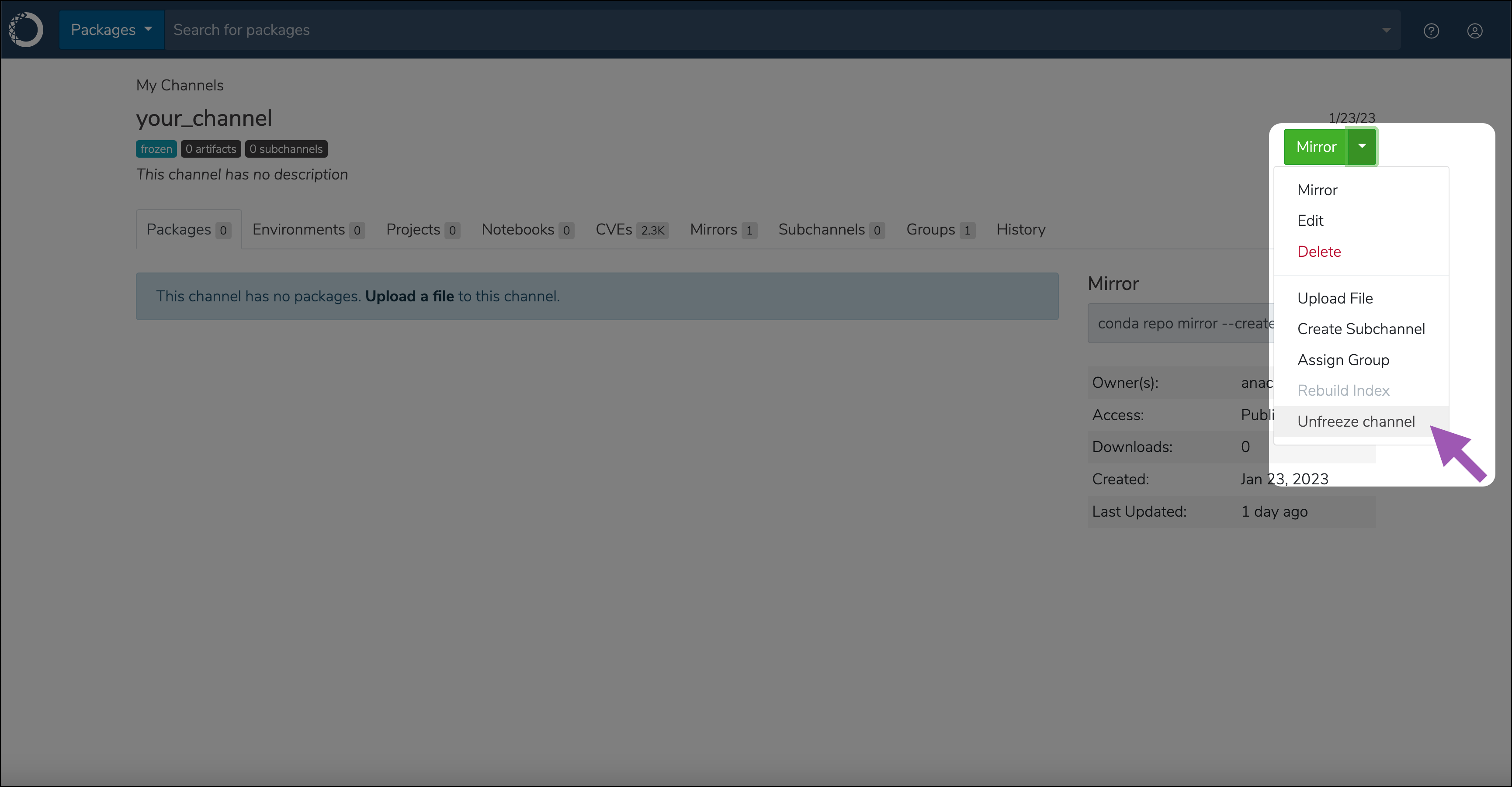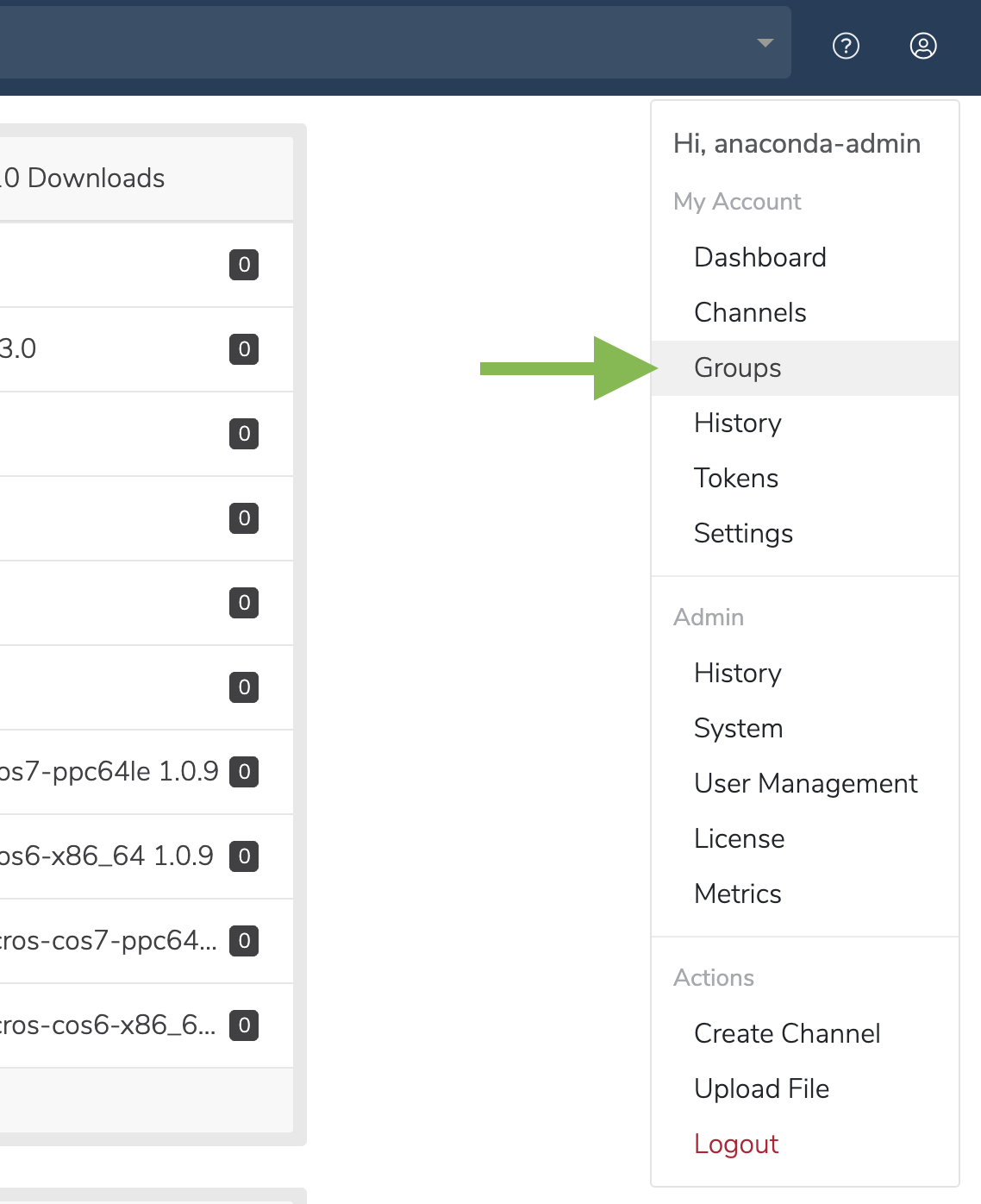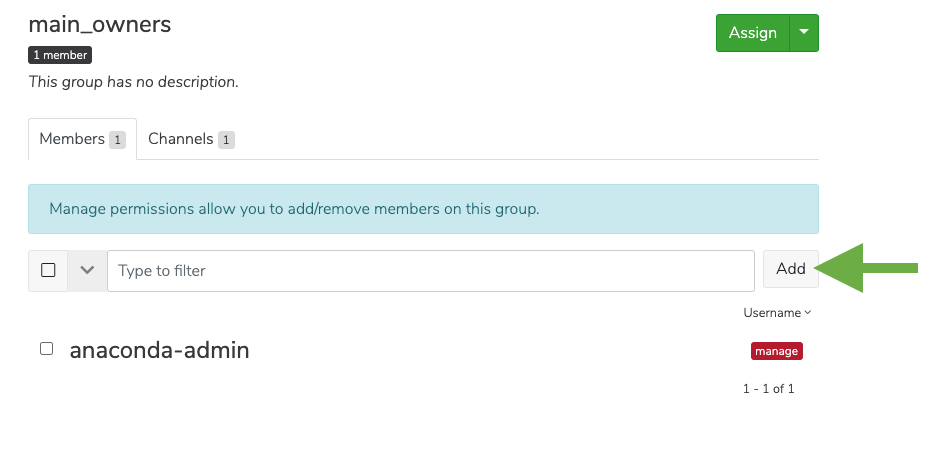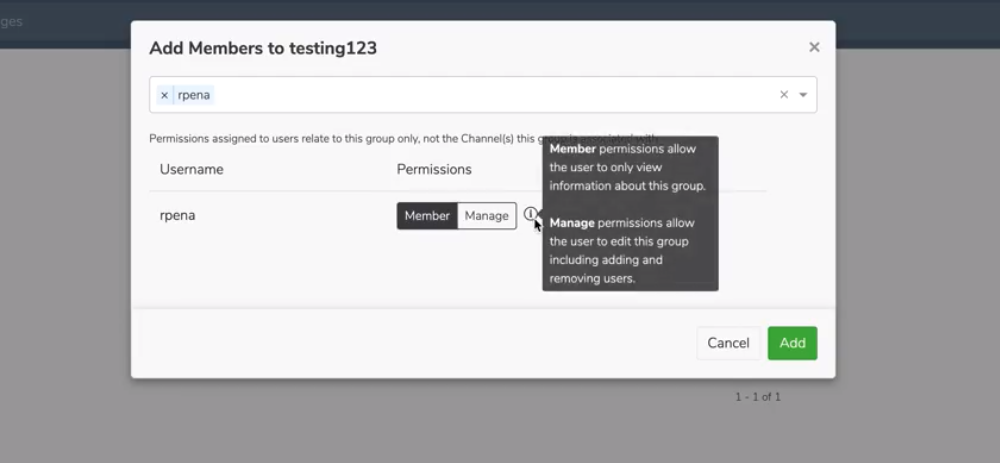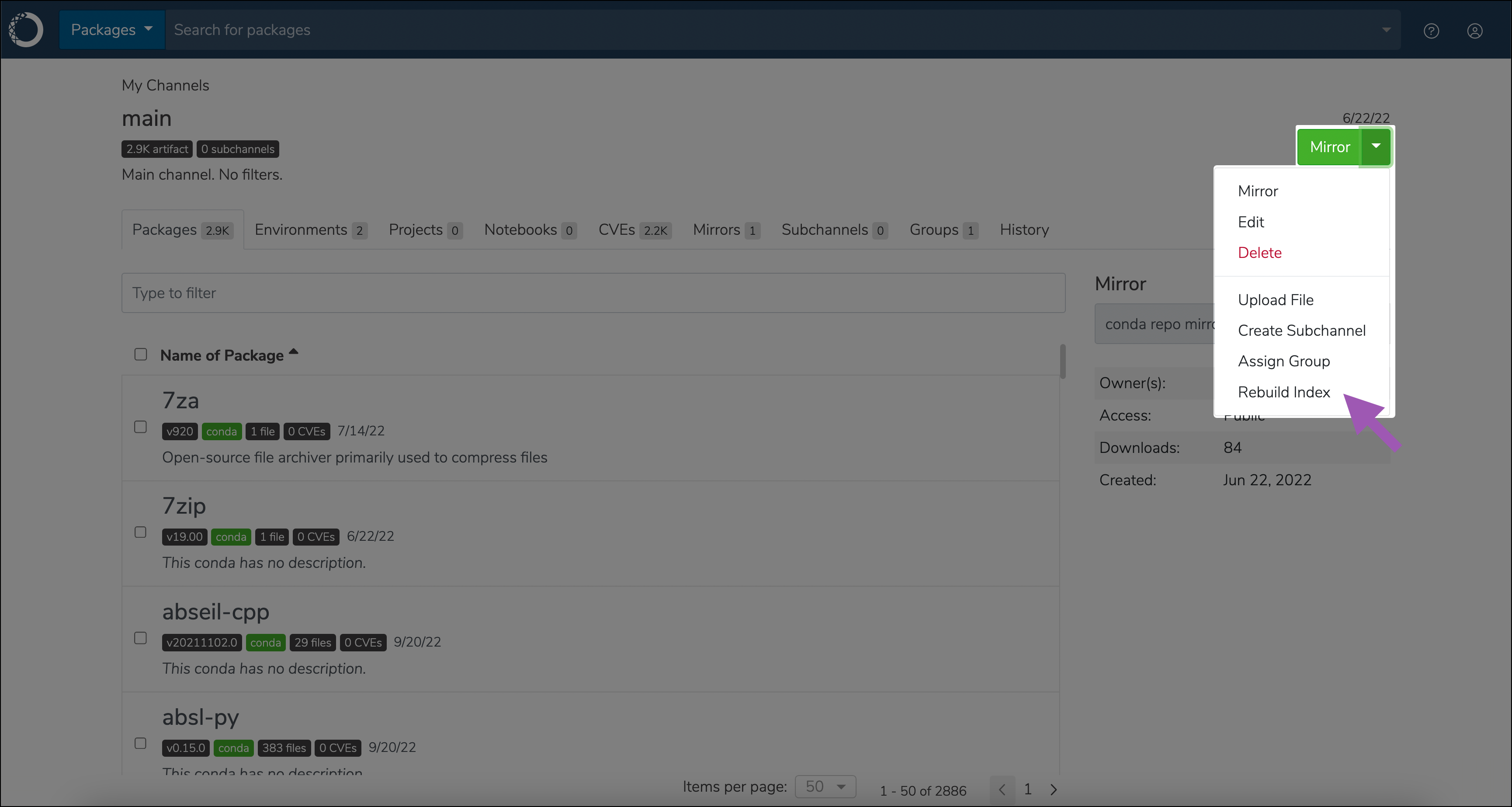Channels and subchannels¶
Anaconda Server contains channels and subchannels, which provide a location in the repository where you can look for artifacts that have been mirrored, uploaded, copied, or moved. Both administrators and users can define channels and subchannels, determine which artifacts are available in a channel or subchannel, and restrict or grant access to specific users or groups.
In Anaconda Server, we allow for an additional level within your channel, called a subchannel (previously called a label in anaconda.org).
When a user logs in to Anaconda Server for the first time, a user profile and default channel will be created. If a channel by that name already exists, a default channel will not be created for that user.
This topic provides guidance on the following actions:
- Creating a channel
- Creating a subchannel
- List channels you can access
- Viewing channel details
- Viewing subchannel details
- Editing a channel
- Editing a subchannel
- Freezing/Unfreezing a channel
- Creating a group
- Adding members to a group
- Assigning a group to a channel
- Deleting a channel
- Running the blob cleanup tool
- Deleting a subchannel
- Rebuilding your channel index
Creating a channel¶
There are a few key things to note when creating a channel:
- If a channel name is already in use, create a new channel with a different name. That channel can then be set as the default channel on the Settings page under My Account.
- If an email is used as a username, the portion of the email before the “@” symbol (also known as the “local-part”) will be used as the username. Because channel names are restricted to a limited set of characters (a-z 0-9 - _), some characters may be replaced with
_. For example, if the email addresserica.lamara@website.comis used as a username, the channelerica_lamarawill be created. - If you don’t see any way of creating a channel (as shown in the following UI section), you may be lacking the permission to do so. Ask your administrator about modifying your permissions to allow you to create channels.
Via the UI:¶
Click to open the User Menu (left click on the user icon in the header on the right side), and then click Create a Channel.
Fill in a name and description when prompted.
You can also create a new channel by clicking on the green button on the top right of the channels list page, or by clicking the plus + icon in the top right of the My Channels list on the dashboard page.
Via the API:¶
<DOMAIN>/swagger/ui/#/channels/repo.endpoints.channels.channels.post_channel
Via the CLI:¶
conda repo channel --create <CHANNEL_NAME>
Creating a subchannel¶
Via the UI:¶
- Go to the details page of a channel.
- You will notice a green button on the right side with an arrow to the right of it. Click that arrow, and then select Create subchannel.
- Fill in a name and description when prompted.
Via the API:¶
POST /api/channels/<CHANNEL_NAME>/subchannels
Via the CLI:¶
conda repo channel --create <CHANNEL_NAME>/<SUBCHANNEL_NAME>
List channels you can access¶
Via the UI:¶
On the dashboard in the top left you will see a list of channels that you have access to. If you have more than 10 channels that you have access to, you can click the Show more button at the bottom of the list of channels. Private channels that you don’t have access to don’t show up.
Alternatively, you can click on the user icon in the header and select Channels to get a list of channels that you own and have access to. If you are an administrator, you will see all channels in your organization.
Via the API:¶
GET /api/channels/
# or
GET /api/account/channels
Via the CLI:¶
conda repo channel --list
Viewing channel details¶
Inside each channel is metadata on the channel, such as the name and description. Additionally, you can get a list of packages, mirrors, subchannels, groups, and history.
Via the UI:¶
- From the dashboard, click on the name of a channel. Alternatively, click on the user menu icon in the far right of the top navigation.
- Select channels to see a list of all the channels you have access to, and then click through to view the details.
or
Type the name of the channel in the search bar at the top of the page and select it from the dropdown.
Via the API:¶
GET /api/channels/<CHANNEL_NAME>
GET /api/channels/<CHANNEL_NAME>/artifacts
GET /api/channels/<CHANNEL_NAME>/history
GET /api/channels/<CHANNEL_NAME>/mirrors
GET /api/channels/<CHANNEL_NAME>/subchannels
Via the CLI:¶
conda repo channel --show <CHANNEL_NAME>
conda repo channel --list-packages <CHANNEL_NAME>
conda repo channel --list-files <CHANNEL_NAME>
Viewing subchannel details¶
Inside each channel is metadata on the channel, such as the name and description. Additionally, you can get a list of packages, mirrors, subchannels, groups, and history.
Via the UI:¶
- Go to the channel’s detail page and click on the Subchannels tab.
- Click on the subchannel to see the subchannel details.
Via the API:¶
GET /api/channels/<CHANNEL_NAME>/subchannels/<SUBCHANNEL_NAME>
GET /api/channels/<CHANNEL_NAME>/subchannels/<SUBCHANNEL_NAME>/artifacts
GET /api/channels/<CHANNEL_NAME>/subchannels/<SUBCHANNEL_NAME>/history
GET /api/channels/<CHANNEL_NAME>/subchannels/<SUBCHANNEL_NAME>/mirrors
Via the CLI:¶
conda repo channel --show <CHANNEL_NAME>/<SUBCHANNEL_NAME>
conda repo channel --list-packages <CHANNEL_NAME>/<SUBCHANNEL_NAME>
conda repo channel --list-files<CHANNEL_NAME>/<SUBCHANNEL_NAME>
Editing a channel¶
Inside each channel is metadata on the channel that you can edit, such as the name, description, and privacy.
Via the UI:¶
- From the dashboard, click on the name of a channel. Alternatively, click on the user menu icon in the far right of the top navigation.
- Select channels to see a list of all the channels you have access to, and then click through to view the details.
- On the channel details page, click the down arrow next to the large green button and select Edit from the menu.
You will be presented with a modal in which you can edit the details of the channel.
Via the API:¶
PUT /api/channels/<CHANNEL_NAME>
Via the CLI:¶
# lock a channel (set the privacy to private)
conda repo channel --lock<CHANNEL_NAME>
# soft-lock a channel (set the privacy to authenticated)
conda repo channel --soft-lock <CHANNEL_NAME>
# unlock a channel (set the privacy to public)
conda repo channel --unlock<CHANNEL_NAME>
Editing a subchannel¶
Via the UI:¶
- Go to a channel’s detail page and click on the Subchannels tab.
- Click on the subchannel you wish to view details for.
- On the subchannel details page, click the down arrow next to the large green button and select Edit from the menu.
You will be presented with a modal in which you can edit the details of the subchannel.
Via the API:¶
PUT /api/channels/<CHANNEL_NAME>/subchannels/<SUBCHANNEL_NAME>
Via the CLI:¶
# lock a subchannel (set the privacy to private)
conda repo channel --lock<CHANNEL_NAME>/<SUBCHANNEL_NAME>
# soft-lock a subchannel (set the privacy to authenticated)
conda repo channel --soft-lock <CHANNEL_NAME>/<SUBCHANNEL_NAME>
# unlock a subchannel (set the privacy to public)
conda repo channel --unlock<CHANNEL_NAME>/<SUBCHANNEL_NAME>
Freezing/Unfreezing a channel¶
Creating a mirror consumes a large amount of CPU resources. This is because, each time an artifact is added to the channel from the mirror, the channel index is rebuilt to add the artifact to the Packages tab of your channel. If you want to conserve or reduce your CPU usage, you can freeze your channel before creating a mirror to prevent the channel index from being rebuilt every time an artifact is registered from the mirror’s source.
Note
Because the channel index is prevented from being built, the Rebuild Index option is disabled while a channel is frozen. Channels and subchannels that are frozen also have their Move and Delete options disabled for packages, projects, environments, and notebooks. In addition, you cannot Copy packages to a channel that is frozen.
You can freeze a channel from the channel’s page. Open the Channel actions dropdown menu and select Freeze Channel.
Frozen channels display a frozen tag below their channel name.
When you freeze a channel, then run a mirror, the History tab will show the mirror starting, artifacts registering, and the mirror completing. Existing packages will not appear in the channel until it is unfrozen.
Once the mirror completes, unfreeze the channel to rebuild the channel index. Open the Channel actions dropdown menu and select Unfreeze Channel, then click Unfreeze in the dialog box that appears. It can take some time for packages to appear in the Packages tab. As a general rule, the larger the repository, the longer the wait.
Note
If you unfreeze your channel before your mirror completes, the indexing operations for artifacts registered while the channel was frozen will occur simultaneously, then the mirror will resume performing normal indexing operations for artifacts as they are registered from the mirror’s source until it completes.
Note
It is not necessary to freeze the channel again once its mirror has completed. The best practice is to freeze the channel, create your mirror, allow it to complete, then unfreeze the channel.
Creating a group¶
Click on the My account button in the top right.
In the dropdown, under My Account, select Groups.
On this page, you can see the groups that have already been created. Click the Create Group button to create a new group.
Enter a unique group name and description, then click Create.
Note
Members can be added to a group once it is created.
Adding members to a group¶
From the group page, click the Add button to add a new member to the group and assign member permissions.
Once the member’s username has populated under Username, you can select their permission level. Click on the information icon next to the permissions to learn more about the permissions available.
Assigning a group to a channel¶
- From the group page, click on the Channels tab.
- If the group has yet to be assigned to a channel, the following notification will be displayed on the page:
Note
This group is not associated with any channels. Assign this group to a channel.
- Click on Assign this group.
- In the popup window, the dropdown search bar will list the channels to which you have permission to modify. Select the channel you wish to add your group to.
- Then, select the permission you wish to assign to the group as a whole, and then click Add.
Deleting a channel¶
Deleting a channel removes it from the channel list. Deleting a channel will also remove all the artifacts associated with that channel from a search, but will not remove the files themselves from the server.
Via the UI:¶
On a channel detail page click the green button’s down arrow to reveal other actions, then click Delete.
Alternatively, on the channels list page, you can click the elipses icon … on the right of each channel row and choose Delete.
Via the API:¶
DELETE /api/channels/<CHANNEL_NAME>
Running the blob cleanup tool¶
The blob cleanup tool removes artifacts associated with deleted channels to free disc space. If an artifact on a deleted channel exists in another channel, it will not be removed. There are two methods for running the blob cleanup tool:
Via the API:¶
Via file configuration¶
You can turn on and schedule the blob cleanup tool to run on its own by adding a few lines of code to the docker-compose.yml file.
Open a terminal.
Log in to your Anaconda Server instance. Speak with your system administrator if you need help with this step.
Open your anaconda installer directory by running the following command:
# Replace <INSTALLER_DIR> with your installer directory cd <INSTALLER_DIR>
Open your
docker-compose.ymlfile.Find the
repo_worker:section of the file and append the following lines:REPO_ENABLE_CLEANUP_BLOBS_JOB=trueREPO_SCHEDULE_CLEANUP_BLOBS_CRON=0 0 1 * *
Save your additions and close the file.
Restart your instance for changes to take effect. To restart your instance, run the following commands:
docker compose down docker compose up -d
The blob cleanup tool runs on a schedule determined by the cron expression in the second line of code you just added to your file. The expression 0 0 1 * * will run the tool on the first day of the month at midnight. To modify when this job runs:
- Open your
docker-compose.ymlfile. - Find the
REPO_SCHEDULE_CLEANUP_BLOBS_CRON=<CRON_EXPRESSION>line and replace the<CRON_EXPRESSION>with a valid cron expression, then save it. - Restart your instance for changes to take effect.
Deleting a subchannel¶
Via the UI:¶
On a channel detail page, click on the subchannels tab. Select one or more subchannels, and then select the down arrow next to the filter text field. A menu will appear where you can select Delete to delete the selected Subchannels.
Alternatively, you can click on a subchannel to view its detail page. From there, click on the green button’s down arrow to reveal other actions, then click Delete.
Via the API:¶
DELETE /api/channels/<CHANNEL_NAME>/subchannels/<SUBCHANNEL_NAME>
Via the CLI:¶
conda repo channel --remove <CHANNEL_NAME>/<SUBCHANNEL_NAME>
Rebuilding your channel index¶
The channel index is automatically rebuilt when certain actions, such as adding or deleting a package, are made. However, if you need to manually rebuild your channel’s index for any reason, follow these steps:
Log in to your instance of Anaconda Server.
Select your channel.
Open the actions dropdown menu and select Rebuild Index.

